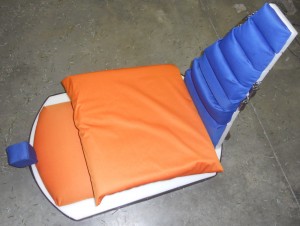Designers: Sahil Prasada, Christopher Thomas, Jack Chen, Zheng Lu
Client Coordinator: Ashley Thomas
Supervising Professor: Larry Bohs
INTRODUCTION
People with spinal cord injuries are unable to fully participate while playing sitting volleyball. The goal of this project was to create a device for people with spinal cord injuries that would increase mobility, stability, and safety. The Volley Trolley is low to the ground, and offers an adjustable backrest to provide personalized support for each user. The padded seat provides comfort and reduces the risk of pressure sores. A backwards tilt on the seat increases user stability. The Volley Trolley empowers players to comfortably play sitting volleyball.
SUMMARY OF IMPACT
The Volley Trolley increases user mobility and provides stability and back support during play. The client commented, “The Volley Trolley is just about the best thing I can imagine. I went from feeling like all I did was struggle to rotate from position to position, to feeling like I can actually participate and play in the game.
TECHNICAL DESCRIPTION
The Volley Trolley (Figure 1) comprises a base, seat bottom, seat back, footrest, footpad, and brake. The base is a 26” L x 17” W x 0.75” H ellipse of High-Density Polyethylene (HDPE). Eleven commercial ball transfers located beneath the base provide ease of motion and stability. The ball transfers are composed of zinc-plated carbon steel with a housing diameter of 2.4” W x 0.86” H. A protective rubber lip composed of Buna-N attaches to the edge of the base to protect the user’s hands from getting pinched by the ball transfers.
The brake consists of two door stops attached to either side of the seat back. When deployed by lowering them to the downward locked position, rubber tips keep the Volley Trolley stable when the user is serving or mounting/dismounting. The stops lift easily into the upper locked position for play. The 15” L x 15” W x 0.75” H seat bottom is composed of HDPE, and attaches to the base through two 2” tall, 0.75” thick, and 0.75” long triangles made of HDPE. These triangles create a slight rearward angle between the seat bottom and back, increasing user stability. The seat bottom is covered with Velcro to facilitate easy attachment of the user’s wheelchair cushion, since this cushion typically provides the best comfort and support for individual users.
The seat back, made from 0.75” thick HDPE, attaches to the base. It tapers from an 11” width at the bottom to 3.5” at the top, with an overall height of 18”. The seat back consists of seven slats, connected together with hinges. The hinges allow the slats to fold back, allowing customization of the seat back height. Commercial cabinet latches, mounted on the lateral edges between slats, lock the desired number of slats together, allowing for easy height adjustment. The seat back is padded with polyurethane foam in an ergonomic shape to provide maximum comfort and stability.
The footrest consists of a foam pad, covered in polyurethane laminate (PUL) fabric, mounted in front of the seat base where the player can comfortably rest her legs. The foot pad is a cushioned post, made from PUL fabric over foam on a plastic post, which keeps the user’s legs from slipping off the base. The post attaches to the base using a pin connection, allowing it to move laterally as the user shifts position.
Figure 2 shows the client using the device. The cost of the components for the device is approximately $370.

